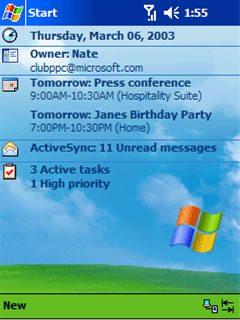Microsoft's new handheld OS


These interface tweaks sit alongside some meatier developments, three of which Microsoft is keen to stress: improved wireless experience, expanded digital media handling and enhanced messaging.
Wireless
Windows Mobile 2003 now handles multiple VPNs and IPSEC, and provides native support for Bluetooth and 802.11b (Wi-Fi) networking. Bluetooth connectivity is catered for by a built-in configuration tool that manages bonding. With Wi-Fi, the OS automatically detects 802.11b networks in the vicinity, asks if you'd like to connect, and prompts for WEP keys. With the settings made once, subsequent connections are transparent and don't require user intervention. Microsoft calls this feature Zero Configuration for Wireless Networks.
Digital media
On the digital media front, we have Windows Media Player 9, among whose enhancements are a dedicated button for accessing streaming media and a mute button. Much is also made of the Sync and Go features in Plus! Digital Media Edition for Windows XP, which let you synchronise media to the Pocket PC's memory or storage cards. This is only going to be of benefit if you use Plus! Digital Media Edition for Windows XP and run Windows Media Player 9 on your desktop, though.
Also for media fans, Microsoft provides one of the two new applications in Windows Mobile 2003. Called Pictures, it's designed for viewing digital images. Functionality is fairly limited, but you can crop and beam images, view them in full-screen slideshow mode and set them as the Today screen wallpaper. Pictures will read cards from digital cameras, although (not surprisingly) we found it rather slow at rendering 4-megapixel images of between 1.5MB and 2MB in size.
The other new application is a game that augments the ubiquitous Solitaire. Called Jawbreaker, it's better known by its previous name, Bubblets, and is an extremely addictive 'match the coloured balls and make them disappear' game.
Messaging
Microsoft's enhanced messaging in Windows Mobile 2003 revolves around tweaks like scheduled synchronisation for wireless connections, with different times between synchronisations during time bands you set as on- and off-peak periods; also new is auto-suggest in email creation and the ability to generate signatures that are automatically attached to emails.
Pocket Internet Explorer has had a major overhaul, with inclusion of support for XHTML, CSS, an increased number of HTML 4 tags, Jscript 5.5, WAP 2.0, WTLS and IPv6. However, Microsoft has not yet implemented a much-desired feature: swivelling the browser window through 90 degrees to allow for a more ergonomic viewing experience of graphics-rich or wide Web pages.
Upgrading to Windows Mobile 2003
All Pocket PC 2002 handhelds have flashable ROM, and Windows Mobile 2003 is not noticeably larger than Pocket PC 2002. It will certainly fit into the Flash ROM available on Pocket PC 2002 devices. So it's theoretically possible for every OEM to provide ROM upgrades. Microsoft is clear that it's up to the OEMs how they approach this -- deciding whether upgrades are to be charged for or free, or offered at all. Most OEMs are sure to move to Windows Mobile 2003 sooner rather than later, but it remains to be seen how many will want to encourage existing owners to upgrade their devices rather than buy new hardware.
Microsoft is introducing Windows Mobile 2003 in a relatively low-key manner -- there will be no grand announcements or launch events. Not surprising, perhaps, as it simply fixes some interface problems, rectifies some obvious faults, adds wireless support and bulks out the package with a couple of new applications. Some developments, notably those relating to wireless connectivity, are significant steps forward, but overall Windows Mobile 2003 is an evolutionary advance.
Interestingly, we've heard nothing so far regarding a new Phone Edition of the Pocket PC OS, although some developments were mentioned as part of the Windows Mobile 2003 briefing. These include standard mobile telephony features like a mute button, separate volume controls for telephony and device sounds, and SMS-triggered notification bubbles that display the content of an incoming message and map to the sender's details if they are in Contacts. The latter feature makes it easy to reply via SMS or phone by tapping a button on the notification bubble.